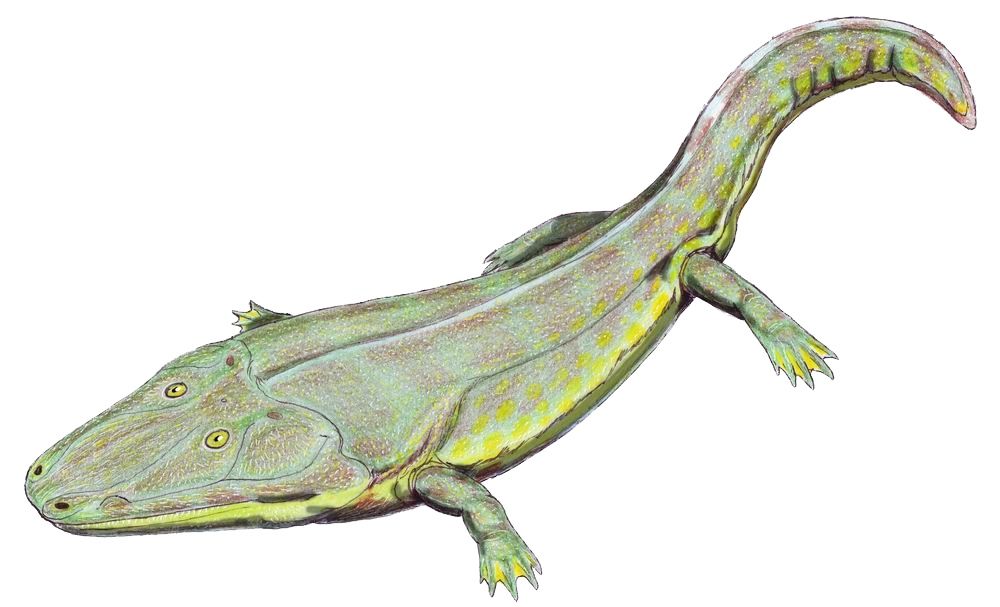|
Cyclotosaurus Robustus
''Cyclotosaurus'' is an extinct genus of temnospondyl within the family Mastodonsauridae. It was of great size for an amphibian, had an elongated skull up to . Etymology The name means "round eared lizard" in Ancient Greek, derived from round openings or fenestrae in the cheeks, which are thought to contain structures of the middle ear. History German naturalist Eberhard Fraas erected the genus ''Cyclotosaurus'' in 1889, with ''C. robustus'' (previously ''Mastodonsaurus robustus'') as the type species. Several species are known, mainly from Germany and Poland in Central Europe, as well as East Greenland and Thailand. The relationships between species is unclear. ''"Labyrinthodon" pachygnathus'' Owen, 1842 and ''"L." leptognathus'' Owen, 1842 were transferred to ''Cyclotosaurus'', as ''C. pachygnathus'' and ''C. leptognathus'', by Paton (1974). However, Damiani (2001) assigned the two species to Mastodonsauroidea indeterminate and Stereospondyli indeterminate. Palaeontology ... [...More Info...] [...Related Items...] OR: [Wikipedia] [Google] [Baidu] |
Middle Triassic
In the geologic timescale, the Middle Triassic is the second of three epochs of the Triassic period or the middle of three series in which the Triassic system is divided in chronostratigraphy. The Middle Triassic spans the time between Ma and Ma (million years ago). It is preceded by the Early Triassic Epoch and followed by the Late Triassic Epoch. The Middle Triassic is divided into the Anisian and Ladinian ages or stages. Formerly the middle series in the Triassic was also known as Muschelkalk. This name is now only used for a specific unit of rock strata with approximately Middle Triassic age, found in western Europe. Middle Triassic fauna Following the Permian–Triassic extinction event, the most devastating of all mass-extinctions, life recovered slowly. In the Middle Triassic, many groups of organisms reached higher diversity again, such as the marine reptiles (e.g. ichthyosaurs, sauropterygians, thallatosaurs), ray-finned fish and many invertebrate groups like ... [...More Info...] [...Related Items...] OR: [Wikipedia] [Google] [Baidu] |
Muschelkalk
The Muschelkalk (German for "shell-bearing limestone"; french: calcaire coquillier) is a sequence of sedimentary rock strata (a lithostratigraphic unit) in the geology of central and western Europe. It has a Middle Triassic (240 to 230 million years) age and forms the middle part of the tripartite Germanic Trias, that give the Triassic its name, lying above the older Buntsandstein and below the younger Keuper. The Muschelkalk (" mussel chalk") consists of a sequence of limestone and dolomite beds. In the past, the time span in which the Muschelkalk was deposited could also be called "Muschelkalk". In modern stratigraphy, however, the name only applies to the stratigraphic unit. Occurrence The name ''Muschelkalk'' was first used by German geologist Georg Christian Füchsel (1722-1773). In 1834, Friedrich August von Alberti included it into the Triassic system. The name indicates a characteristic feature of the unit, namely the frequent occurrence of lenticular banks composed o ... [...More Info...] [...Related Items...] OR: [Wikipedia] [Google] [Baidu] |
Fleming Fjord Formation
The Fleming Fjord Formation, alternatively called the Fleming Fjord Group is an Upper Triassic geological formation in the northeastern coast of Jameson Land, Greenland. It consists of terrestrial sediments and is known for its fossil content. Description It is of Norian to Rhaetian age and is subdivided into three members; at the base the Edderfugledal Member, followed by the Malmros Klint Member with the Ørsted Dal Member at the top. It was deposited in a large shallow to ephemeral lake. Paleobiota The fauna of Fleming Fjord is diverse, including sauropodomorph dinosaurs, pterosaurs, temnospondyls, mammaliaforms, aetosaurs, and other taxa. Freshwater unionid bivalves and conchostracans have been reported from the Malmros Klint Member. Fish Lungfish, actinopterygian, and chondrichthyan teeth have been reported from the Malmros Klint Member. Amphibians Reptiles Besides the forms described below, a diverse ichnofauna of small and large tracks has also been reported ... [...More Info...] [...Related Items...] OR: [Wikipedia] [Google] [Baidu] |
Bielefeld
Bielefeld () is a city in the Ostwestfalen-Lippe Region in the north-east of North Rhine-Westphalia, Germany. With a population of 341,755, it is also the most populous city in the administrative region (''Regierungsbezirk'') of Detmold and the 18th largest city in Germany. The historical centre of the city is situated north of the Teutoburg Forest line of hills, but modern Bielefeld also incorporates boroughs on the opposite side and on the hills. The city is situated on the ', a hiking trail which runs for 156 km along the length of the Teutoburg Forest. Bielefeld is home to a significant number of internationally operating companies, including Dr. Oetker, Gildemeister and Schüco. It has a university and several technical colleges ('' Fachhochschulen''). Bielefeld is also famous for the Bethel Institution, and for the Bielefeld conspiracy, which satirises conspiracy theories by claiming that Bielefeld does not exist. This concept has been used in the town's marketing ... [...More Info...] [...Related Items...] OR: [Wikipedia] [Google] [Baidu] |
Stuttgart Formation
The Stuttgart Formation is a geologic formation in Germany. It preserves fossils dating back to the Carnian stage of the Triassic period.Stuttgart Formation at .org Fossil content Temnospondyls * ''''Witzmann et al., 2016 * '' C. robustus''Schoch & Milner, 2000 * ''[...More Info...] [...Related Items...] OR: [Wikipedia] [Google] [Baidu] |
Chulabhorn Dam
Chulabhorn Dam (เขื่อนจุฬาภรณ์) is a dam in Tambon Thung Lui Lai, Khon San District, Chaiyaphum Province, Thailand. It impounds the Phrom River, a tributary of the Mekong. The dam has diverted the Nam Phrong River. As water leaves its turbines, it empties into the Choen River. The dam is named for Princess Chulabhorn of Thailand. Description Typical of Thai dams, the Chulabhorn Dam is an earth core rockfill dam. Its function is to generate electricity and to irrigate riparian agriculture, except when irrigation is prohibited during droughts. The dam is long and high. Its reservoir covers . A replica of Phra Phutthasiri Sakkharat (Luangpho Chet Kasat) (พระพุทธสิริสัคคราชจำลอง (หลวงพ่อเจ็ดกษัตริย์)) is a Buddha image enshrined on the left side of the dam, opposite Chulabhorn Dam Park. The Chulabhorn Dam Park (สวนเขื่อนจุฬาภรณ์) covers ap ... [...More Info...] [...Related Items...] OR: [Wikipedia] [Google] [Baidu] |
Pfaffenhofen (district)
Pfaffenhofen () is a ''Landkreis'' (district) in Bavaria, Germany. It is bounded by (from the south and clockwise) the districts of Eichstätt, Kelheim, Freising, Dachau and Neuburg-Schrobenhausen, and the city of Ingolstadt. History In early medieval times the region was partially property of the powerful monasteries of Ilmmünster and Münchsmünster, and partially divided into tiny secular states. One of those states was the county of Scheyern. The counts were ancestors of the Wittelsbach family, who in 1180 became rulers of Bavaria. From that time on the region was a part of Bavaria. The district of Pfaffenhofen was established in 1972 by merging several former districts. Geography The district is located in the Hallertau Plains between the Isar and Danube rivers. The Danube crosses the northernmost part of the district. Coat of arms The coat of arms displays: * the white and blue lozenges of Bavaria * a cross symbolising the monastery of Scheyern * a branch of hops Towns ... [...More Info...] [...Related Items...] OR: [Wikipedia] [Google] [Baidu] |
Krasiejów
Krasiejów (german: Krascheow) is a village in the administrative district of Gmina Ozimek, within Opole County, Opole Voivodeship, in south-western Poland. It lies approximately east of Ozimek and east of the regional capital Opole. The village has a population of 2,050. Paleontological localities Abundant skeletons of the Upper Triassic tetrapods (i.e., large Temnospondyli: '' Metoposaurus'' and ''Cyclotosaurus''; reptiles: ''Paleorhinus'', dinosauriformes ''Silesaurus'') were described from the pit. Two paleontological museums and large dinopark (so-called JuraPark) are at Krasiejów. Some microvertebrate fossils, fossil plants, bivalves, crustaceans and fish scales were also collected at the site. History The village was first mentioned in the 13th century, when it was part of Piast-ruled Poland. Its name is of Polish origin, and comes from the Old Polish words ''kraszenie'' or ''krasny''. Later on, the village was also part of Bohemia (Czechia), Prussia and German ... [...More Info...] [...Related Items...] OR: [Wikipedia] [Google] [Baidu] |
Ebrach
Ebrach is a municipality with market rights in the Upper Franconian district of Bamberg (district), Bamberg and the seat of the ''Municipal association, Verwaltungsgemeinschaft'' (municipal association) of Ebrach. Geography Ebrach lies between Bamberg in the east and Würzburg in the west. It is located in the Steigerwald on the river Mittlere Ebrach. Constituent communities Ebrach’s main and namesake centre is by far the biggest of its ''Ortsteile'' with a population of 1,078. The market community furthermore has these outlying centres, each given here with its own population figure: *Buch bei Ebrach: 55 *Eberau bei Ebrach: 122 *Großbirkach: 68 *Großgressingen: 251 *Hof bei Ebrach: 15 *Kleinbirkach: 36 *Kleingressingen: 40 *Meierei bei Ebrach: 7 *Neudorf bei Ebrach: 93 *Schmerb: 4 *Winkelhof: 6 The community also has five traditional rural land units, known in German language, German as ''Gemarkungen'', named Buch, Ebrach, Großbirkach, Großgressingen and Neudorf bei Ebrac ... [...More Info...] [...Related Items...] OR: [Wikipedia] [Google] [Baidu] |
Blasensandstein Formation
The Blasensandstein is a Carnian geologic member in Bavaria, Germany. It is part of the Hassberge Formation. Fossil theropod tracks have been reported from the formation.Weishampel et al., 2004, pp.517-607 See also * List of dinosaur-bearing rock formations ** List of stratigraphic units with theropod tracks The following tables list the global geological sites where tracks of theropod dinosaurs have been found, together with the proper names of the rock formations (stratigraphic units) that contain them. Non-avian theropods Avialans See also *L ... References Bibliography * {{ISBN, 0-520-24209-2 Geologic formations of Germany Triassic System of Europe Triassic Germany Carnian Stage Sandstone formations Lacustrine deposits Ichnofossiliferous formations Paleontology in Germany ... [...More Info...] [...Related Items...] OR: [Wikipedia] [Google] [Baidu] |
Stuttgart-Feuerbach
Feuerbach is a borough (''Stadtbezirk'') of the city of Stuttgart. Its name is derived from the small river of the same name that flows from the neighboring district of Botnang through Feuerbach. Feuerbach is home to one of Germany's biggest industrial giants and is surrounded by the districts of Zuffenhausen, Bad Cannstatt, Stuttgart-North, Stuttgart-West, Botnang and Weilimdorf. History The remains of a prehistoric settlement were uncovered in 1904, when the pastor of Feuerbach, Richard Kallee excavated, archeologically documented and published a total of 102 Alemannic sandstone tombs and cists. Heinz Krämer: Fertig Feuerbach! Richard Kallee, Pfarrer und Geschichtsforscher '' in German, DRW Verlag, Leinfelden-Echterdingen, 2004, . Was die alten Steine in Feuerbach erzählen'' in German, 1923. Together with his helpers he took great care to recover 760 artifacts from these Alemannic graves: skulls and bones, coins, pottery shards, combs, necklaces, belts, locks, swords, sp ... [...More Info...] [...Related Items...] OR: [Wikipedia] [Google] [Baidu] |



